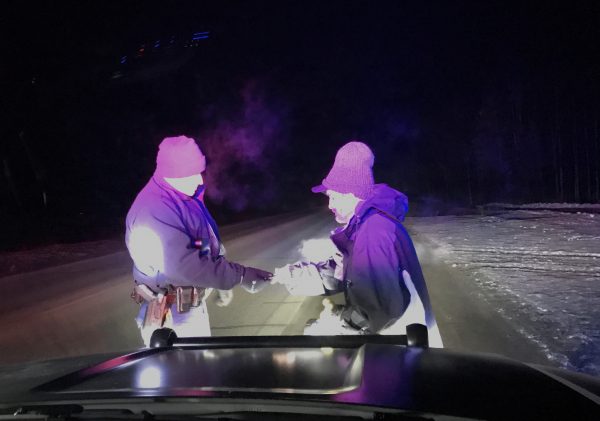The Alaska State Troopers are at “critically low” staffing levels, according to a recruitment and retention plan report from the Department of Public Safety.

Budget cuts have trimmed the number of trooper positions across the state, but the department is also struggling to keep troopers in the existing positions.
The retention plan report says troopers are leaving for better pay and retirement elsewhere, and low staffing is hurting the agency’s ability to respond to calls for help.
To get a closer look at what the troopers are dealing with, I took a ride with Trooper Lee Phillips on a recent Saturday night in Wasilla.
“I really enjoy what I do,” Phillips said. “Believe it or not, this might sound corny, but I really enjoy helping people.”
Phillips got a call that dozens of teenagers were drinking and fighting at a party. A neighbor had fired a gun into the air trying to break it up. Phillips flipped on his flashing lights and siren.
“Sometimes they start ganging up on one kid, kicking him in the head, weapons start getting pulled out, so the sooner we get there the better,” Phillips said.
Soon, we were doing 90 miles an hour, and I have to admit, it was kind of a thrill. But not every call that night was as exciting. Phillips pulled over some cars, stopped to direct traffic past a wreck and counseled a woman after a domestic disturbance.
It wasn’t all flashing lights and sirens, but it all took patience and time. And on some nights, the troopers don’t have as much time to deal with anything except the highest priority calls.
“You’re just call to call to call to call,” Phillips said. “And it’s like, dispatch is like, ‘Hey can you break soon? We got an assault pending.’ That’s frustrating when you can’t do your job to the best of your ability because there’s so much other calls pending because of lack of manpower.”
Phillips worries things could get worse. He’s not the only one.
“We are in a crisis. We’re struggling to make this work,” Doug Massie said. Massie is a 20-year wildlife trooper and president of the Department of Public Safety chapter of the Public Safety Employees Association.
“I think we’re doing the best we can, but we don’t have adequate funding or staffing that we need to provide public safety to the citizens of Alaska,” Massie said.
Massie pointed to the numbers in the retention plan report. Roughly 10 percent of trooper positions statewide are unfilled. The rate of troopers leaving for other jobs has nearly doubled. Most go to other law enforcement agencies.
“They are definitely bargain hunting. They’re looking for the best pay, the best benefits and what the department has to offer them, so they’re more willing to separate and go a different direction,” Massie said.
It’s not easy training new troopers. A tiny fraction of applicants make it through the process. It takes up to a year and a half and nearly $200,000 to train one trooper.
To keep the ones they already have, the Department of Public Safety retention plan suggests returning Alaska law enforcement officers to a defined-benefit retirement plan. That’s what they used to offer and it guaranteed a certain level of retirement benefits after 20 years of employment. The defined-contribution plan state employees currently get is an investment account that can be cashed out in full after just five years.
Lt. Derek DeGraaf heads the troopers’ recruitment office, which is now increasingly focused on retention as well.
“So we moved the finish line, essentially, to five years,” DeGraaf said. “I heard it said many years ago when we switched over to this, ‘Give us five years, and that’s adequate,’ and it’s just not. It’s just really costly, it becomes more of a revolving door.”
DeGraaf said police departments at the same job fairs he attends in the Lower 48 — hoping to stop attrition and become more attractive to recruits — have returned to defined-benefit plans.
“The cost, after losing that, with the revolving door and the training and the lack of police services to the public, became such an issue that they brought them back,” DeGraaf said.
The Department of Public Safety has several other retention initiatives, but a defined-benefit retirement package is at the top of its list. It’s also at the top of a list of suggestions for retaining troopers recommended by the troopers themselves in a recent survey. About half said better pay and better retirement are the best ways to keep troopers.
That argument may have gained traction in the Alaska Legislature. A recent bill by Senate President Pete Kelly, a Republican from Fairbanks, would allow police officers, troopers and firefighters to return to a defined-benefit plan.
Kelly said a cost analysis still needs to be done.
“And the numbers need to be compelling, or this Legislature probably won’t do it,” Kelly said. “But I think we actually can find that those numbers do produce a benefit to the state of Alaska. That remains to be seen, we haven’t had that work done yet, but the bill is filed.”
That bill would only affect public safety employees. Sen. Dennis Egan, a Juneau Democrat, and others say all public employees — including teachers and state workers — should be in the same, larger pool, which he says would keep down costs. Egan also has a bill filed that would give public employees the option of going with defined benefits.
But Massey, the troopers union president, said that if its comes down to a higher price tag, the state should prioritize public safety and the dangerous daily conditions of law enforcement work.
“When anyone asks, ‘What makes you think you’re different?’ my answer is, ‘We are. Period,'” Massie said.
Back on patrol, Trooper Lee Phillips had wrapped up at the party. A couple other troopers responded, they investigated some possible underage drinking, but if there was a fight, nobody got hurt.
Phillips said the trooper numbers were adequate that night, but that’s not always the case. If he’d been alone, he would’ve been outnumbered 100 to one.
“That, right there, is a prime reason that when we’re shorthanded it’s just not good,” Phillips said. “Say someone has a prisoner, someone else is out on another call, and someone’s on a death investigation, and then it’s one trooper dealing with this whole thing. It’s not a safe situation for anybody.”
While Phillips and his fellow troopers continue to work to meet the daily demand, the Legislature will examine the costs associated with the bills by Senators Kelly and Egan, as well as the cost to public safety if troopers continue to leave.
Casey Grove is host of Alaska News Nightly, a general assignment reporter and an editor at Alaska Public Media. Reach him at cgrove@alaskapublic.org. Read more about Casey here.




